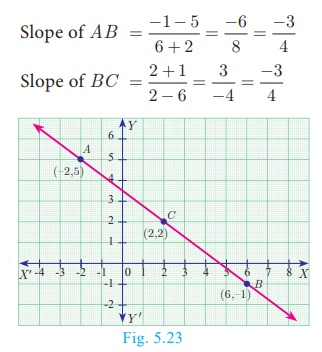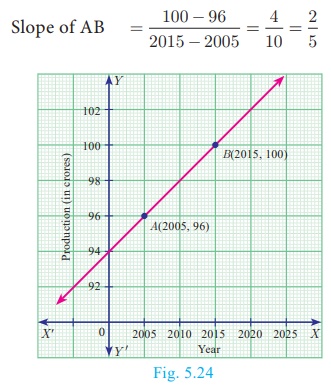Slopes | Coordinate Geometry - Inclination of a line | 10th Mathematics : UNIT 5 : Coordinate Geometry
Chapter: 10th Mathematics : UNIT 5 : Coordinate Geometry
Inclination of a line
Inclination of a line
The inclination of a line or the angle of inclination of a line is the angle
which a straight line makes with the positive direction of X axis
measured in the counter-clockwise direction to the part of the line above the X
axis. The inclination of the line is usually denoted by θ.
Note
·
The inclination of X axis and every line parallel to X
axis is 0°.
·
The inclination of Y axis and every line parallel to Y
axis is 90°.
1. Slope of a Straight line
While laying roads one must know how steep the road will be.
Similarly, when constructing a staircase, we should consider its steepness. For
the same reason, anyone travelling along a hill or a bridge, feels hard
compared to travelling along a plain road.
All these examples illustrate one important aspect called
“Steepness”. The measure of steepness is called slope or gradient.

The concept of slope is important in economics because it is used to measure the rate at which the demand for a product changes in a given period of time on the basis of its price. Slope comprises of two factors namely steepness and direction.
Definition
If θ is the angle of inclination of a non -vertical
straight line, then tanθ is called the slope or gradient of the line and
is denoted by m.
Therefore the slope of the straight line is m = tan θ
, 0 ≤ θ ≤ 180° , θ ≠ 90°
To find the slope of a straight line when two points are given
Slope m = tan θ

The slope of the line through (x 1 , y1
) and (x 2 , y2 ) with x 1
≠ x2 is  .
.
Note
The slope of a vertical line is undefined
Values of slopes

2. Slopes of parallel lines
Two non-vertical lines are parallel if and only if their slopes are equal.
Let l1 and l2 be two
non-vertical lines with slopes m1 and m2
respectively.
Let the inclination of the lines with positive direction of X
axis be θ1 and θ2 respectively.

Assume, l1 and l2are parallel
θ1 = θ2 (Since, θ1 , θ2
are corresponding angles)
tan θ1= tan θ2
m1= m2
Hence, the slopes are equal.
Therefore, non-vertical parallel lines have equal slopes.
Conversely
Let the slopes be equal, then m1 = m2
tan θ 1= tan θ 2
θ1= θ2 (since 0 ≤ θ1 , θ2
≤ 180°)
That is the corresponding angles are equal.
Therfore, l1 and l2 are
parallel
Thus, non-vertical lines having equal slopes are parallel.
Hence, non vertical lines are parallel if and only if their slopes are equal.
3. Slopes of perpendicular lines
Two non-vertical lines with slopes m1 and m2
are perpendicular if and only if m1m2 = −1
Let l1 and l2 be two
non-vertical lines with slopes m1 and m2 ,
respectively. Let their inclinations be θ1 and θ2
respectively.

Then m1 = tan θ1
and m2 = tan θ2
First we assume that, l1 and l2
are perpendicular to each other.
Then ∠ABC = 90° − θ1
(sum of angles of ΔABC is 180° )
Now measuring slope of l2 through angles θ2
and 90° − θ1 , which are opposite to each other, we get
tan θ2 = −tan(90° − θ1 )

tan θ1 . tan θ2 = −1
m1 .m2 = −1
Thus, when the line l1 is perpendicular to line l2 then m1m2 = −1 .
Conversely,
Let l1 and l2 be two
non-vertical lines with slopes m1 and m2
respectively, such that m1m2 = −1
.
Since m1 = tan θ 1 , m2
= tan θ2
We have tan θ1 tan θ2 = −1
tan θ1 = −1/ tan θ2
tan θ1 = −cot θ2
tan θ1 = −tan(90° - θ2)
tan θ1 = tan(-(90° - θ2)) =
tan(θ2 - 90°)
θ1 = θ2 - 90° (since 0 ≤ θ1, θ2
≤ 180)
θ2 = 90° + θ1
But in ΔABC, θ2 = ∠C + θ1
Therefore, ∠C = 90°
Note
Let l1 and l2
be two lines with well-defined slopes m1 and
m2 respectively, then
(i) l1 is parallel to l2 if and only if m1
= m2 .
(ii) l1 is perpendicular to l2 if and only if m1m2
= −1.
Example 5.8
(i) What is the slope of a line whose inclination is 30° ?
(ii) What is the inclination of a line whose slope is √3?
Solution
(i) Here θ = 30°
Slope m = tan θ
Therefore, slope m = tan 30° = 1 /√3
(ii) Given m = √3 let θ be the inclination of the
line
tan θ = √3
We get, θ = 60°
Example 5.9
Find the slope of a line joining the given points
(i) (-6, 1) and (-3, 2)
(ii) (-1/3, ½) , and (2/7, 3/7) (iii) (14, 10) and (14, -6)
Solution
(i) (-6, 1) and (-3, 2)
The slope 
(iii) (14, 10) and (14, - 6)

The slope is undefined.
Example 5.10
The line r passes through the points (–2, 2) and (5, 8) and the line s passes through the points (–8, 7) and (–2, 0).
Is the line r perpendicular to s ?
Solution

That is,m1m2 = −1
Therefore, the line r is perpendicular to line s.
Example 5.11
The line p passes through the points (3, - 2) , (12, 4) and the line q passes through the points (6, - 2) and (12, 2) . Is p
parallel to q ?
Solution

Thus, slope of line p = slope of line q.
Therefore, line p is parallel to the line q.
Example 5.12
Show that the points (-2, 5) , (6, -1) and (2, 2) are collinear.
Solution
The vertices are A(-2, 5) , B(6, -1) and C(2, 2).

We get, Slope of AB = Slope of BC
Therefore, the points A, B, C all lie in a same straight
line.
Hence the points A, B and C are collinear.
Example 5.13
Let A(1, - 2) , B(6, - 2) , C(5, 1) and D(2, 1) be four points
(i) Find the slope of the line segments (a) AB
(b) CD
(ii) Find the slope of the line segments (a) BC (b) AD
(iii) What can you deduce from your answer.
Solution

(iii) The slope of AB and CD are equal so AB, CD are parallel.
Similarly the lines AD and BC are not parallel, since their slopes
are not equal. So, we can deduce that the quadrilateral ABCD is a trapezium.
Example 5.14
Consider the graph representing growth of population (in crores).
Find the slope of the line AB
and hence estimate the population in the year 2030?
Solution
The points A(2005, 96) and B(2015, 100) are on the line AB.

Let the growth of population in 2030 be k crores.
Assuming that the point C (2030,k) is on AB,
we have, slope of AC = slope of AB

k - 96 = 10
k = 106
Hence the estimated population in 2030 = 106 Crores.
Example 5.15
Without using Pythagoras theorem, show that the points (1, - 4) , (2, - 3) and (4, - 7) form a
right angled triangle.
Solution
Let the given points be A(1, - 4) , B(2, - 3) and C(4,
- 7).

Slope of AB × slope of AC = (1)(−1) = −1
AB is perpendicular to AC. ∠A = 90°
Therefore, ΔABC is a right angled triangle.
Example 5.16
Prove analytically that the line segment joining the mid-points of
two sides
of a triangle is
parallel to the third side and is equal to half of its length.
Solution
Let P (a,b) Q (c,d) and R(e, f ) be the vertices of a
triangle.
Let S be the mid-point of PQ and T be the mid-point
of PR

Therefore, ST is parallel to QR. (since, their
slopes are equal)
Also

Thus
ST is parallel to QR and half of it.
Note
This example illustrates how a geometrical result can be proved
using coordinate Geometry.
Related Topics